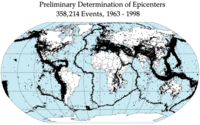
Photo from wikipedia
Independent component analysis (ICA) is an excellent latent variables (LVs) extraction method that can maximize the non-Gaussianity between LVs to extract statistically independent latent variables and which has been widely… Click to show full abstract
Independent component analysis (ICA) is an excellent latent variables (LVs) extraction method that can maximize the non-Gaussianity between LVs to extract statistically independent latent variables and which has been widely used in multivariate statistical process monitoring (MSPM). The underlying assumption of ICA is that the observation data are composed of linear combinations of LVs that are statistically independent. However, the assumption is invalid because the observation data are always derived from the nonlinear mixture of LVs due to the nonlinear characteristic in industrial processes. Under this circumstance, the ICA-based fault detection is unable to provide accurate detection for specific faults of industrial processes. Since the observation data come from the nonlinear mixing of LVs, this makes the observation data change faster than the intrinsic LVs on the time scale. The temporal slowness can be regarded as an additional criterion in the extraction of LVs. The slow feature analysis (SFA) derived from the temporal slowness has received extensive attention and application in MSPM in recent years. Simultaneously, the temporal slowness is expected to make up for the problem that the LVs extracted by ICA have difficulty accurately describing the characteristics of the process. To solve the above problems, this work proposes to monitor non-Gaussian and nonlinear processes using the independent slow feature analysis (ISFA) that combines statistical independence and temporal slowness in extracting the LVs. When the observation data are composed of a nonlinear mixture of LVs, the extracted LVs of ISFA can describe the characteristics of the processes better than ICA, thereby improving the accuracy of fault detection for the non-Gaussian and nonlinear processes. The superiority of the proposed method is verified by a numerical example design and the Tennessee–Eastman process.
Journal Title: ACS Omega
Year Published: 2022
Link to full text (if available)
Share on Social Media: Sign Up to like & get
recommendations!